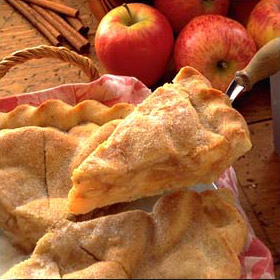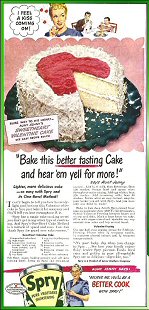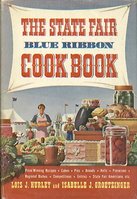Home bakers rise up
 Crisco has just announced its shortening is going to a new formula with zero grams of transfats per serving. The new formula “uses less partially hydrogenated cottonseed and soybean oils and more fully hydrogenated cottonseed oil — which contains no transfat.”
Crisco has just announced its shortening is going to a new formula with zero grams of transfats per serving. The new formula “uses less partially hydrogenated cottonseed and soybean oils and more fully hydrogenated cottonseed oil — which contains no transfat.” Some home bakers reacted to the news just as Wendy Mitchell did in this humorous piece in the Ledger Independent of Maysville, KY:
The food Nazis have gone too far. They are messing with an American icon, apple pie. What is pie without a firm, flaky crust? There are too few pleasures in life and my pie crust, with REAL Crisco is one of them. You need Crisco for that.
Now the company that makes Crisco has caved to the food Nazis and is changing the recipe. Leave my Crisco alone. Thanks to some transfat Mafia I will have to go shopping for Crisco tonight. A lot of it.
How long does Crisco last? I will be finding out. I have also been trying to calculate how much Crisco I will need to make it through the rest of my life without having to purchase the trans fatless concoction the company claims tastes and cooks the same.
Say five pounds a year, plus an extra can for holidays and special events, like the time I made 65 pies for a benefit sale in one day. That took five pounds all by itself....
How do you take something like transfat out ... by adding something else. How do I know that the something else won't be bad for me...
Crisco lovers unite! Put your cans on the line. Demand equal product access with the trans fatless and cookie on!
Others who grew up on shortening likely had similar reactions.
Spry, Crisco and other shortenings have been staples in American kitchens since the turn of the last century. The old cookbooks of our mothers, grandmothers and great grandmothers hold some of America’s still-favorite family recipes, made with shortening.  All-vegetable shortenings were welcomed by home cooks for their purity and clean taste when they were first introduced in 1911. They were considerably safer than the often contaminated and adulterated lards and fats sold before their introduction. For many home bakers, shortening is the secret to achieving flaky pie crusts, delicate cookies and light cakes. That’s because the these fats inhibit long strands of gluten from forming in wheat doughs — hence, their name “shortening.” Shortening has enabled many women over the past century to win coveted blue ribbons at state and county fairs.
All-vegetable shortenings were welcomed by home cooks for their purity and clean taste when they were first introduced in 1911. They were considerably safer than the often contaminated and adulterated lards and fats sold before their introduction. For many home bakers, shortening is the secret to achieving flaky pie crusts, delicate cookies and light cakes. That’s because the these fats inhibit long strands of gluten from forming in wheat doughs — hence, their name “shortening.” Shortening has enabled many women over the past century to win coveted blue ribbons at state and county fairs.
Partially hydrogenated oils, as in shortening, have other benefits for home cooks and commercial cooks, alike.
They help to keep cookies softer and lighter. [Make a batch of cookies with butter and one with shortening and see how much higher and lighter the shortening cookies are.]
Shortening has a higher smoke point (the temperature that an oil or fat breaks down, smokes or burns, and gives food an awful taste) than butter, margarine and many other oils, making it safer for frying and more ideal for achieving crisp French fries and donuts that have a delicate crust without being greasy inside. Deep fat fryers were standard kitchen items in many homes during the middle of the last century. Our Mother made donuts nearly every weekend and even more often made potato fries to go with her burgers, sloppy joes or fried chicken. Because these foods are eaten away from home moreso today and not made by Mom, many people fear they are somehow less good-for-us. But there is no credible evidence for such fears. (Although some Moms may have been better cooks than the kids in the red uniforms.)
Partially hydrogenating vegetable oils also makes them more stable and go rancid less quickly, meaning they can be safely stored for much longer periods than other oils. They came to be pantry stables, especially during war times and the Great Depression.
 A lot of people today are being led to believe that transfatty acids are some new chemical being snuck into processed foods by evil food corporations and that they are totally unnecessary. This conspiracy thinking fails to understand history and the science of fatty acids. As Dr. David Klurfeld said in Nutrition News Focus: “Transfats are not there because the manufacturers don’t care about your health. If you want a cracker that does not go rancid during the summer or leaves a greasy stain on the pantry shelf, you cannot make it with a highly unsaturated fat like soybean oil. You either use lard or hydrogenated vegetable oils.”
A lot of people today are being led to believe that transfatty acids are some new chemical being snuck into processed foods by evil food corporations and that they are totally unnecessary. This conspiracy thinking fails to understand history and the science of fatty acids. As Dr. David Klurfeld said in Nutrition News Focus: “Transfats are not there because the manufacturers don’t care about your health. If you want a cracker that does not go rancid during the summer or leaves a greasy stain on the pantry shelf, you cannot make it with a highly unsaturated fat like soybean oil. You either use lard or hydrogenated vegetable oils.”
Is there any evidence that whatever is going to be substituted for partially hydrogenated oils is any better for us? Of course not. This was never really a health issue. The dreaded transfats in our foods are a tiny fraction of the calories and fats in our diet. There is no need for most of us to fear that a minuscule amount of some nutrient in our food might harm us (or conversely, believe it has curative properties). “The dose makes the poison,” as the scientific adage goes. Thank goodness for that, too, or the human race wouldn’t have survived millennia, oftentimes eating stuff that would curl the toes of many today.
 But consumers might find it reassuring to learn that since 1910, our consumption of total fats in cooking and baking has remained constant, averaging about 22 pounds per person per year (peaking at 23.5 pounds in 1950), according to the U.S. Department of Agriculture. Meanwhile, as recently explained, we’re healthier and living longer than ever.
But consumers might find it reassuring to learn that since 1910, our consumption of total fats in cooking and baking has remained constant, averaging about 22 pounds per person per year (peaking at 23.5 pounds in 1950), according to the U.S. Department of Agriculture. Meanwhile, as recently explained, we’re healthier and living longer than ever.
Yet this panic over transfats has led many to believe there is something especially dangerous about partially hydrogenated fats. Yes, transfats are not all “manufactured.” They also occur naturally in many other healthful foods such as meat and dairy products. The U.S. Department of Agriculture estimates that 25 percent of transfats in a typical diet come from natural sources like beef, milk or lamb. In fact, trying to needlessly eliminate transfats from our diet could actually create health problems and lead to shortages in many important food nutrients found in baked goods, meats and dairy foods, according to the FDA.
Ms Mitchell may be right to be concerned that eliminating transfats from shortening could make a taste difference. When Mister Bee, the only producer of potato chips in West Virginia, went to a “healthier” cottonseed oil to fry its potato chips last summer, customers noticed immediately and the company received 15 angry customer calls a day and their sales dropped 6%. Customers said the new chip was darker in color, greasier and left an aftertaste. Mister Bee President Alan Klein admitted to the San Francisco Chronicle that there was a 'noticeable difference' in the new chip’s taste after being in the package for a couple of days. The company listened to customers and went back to the old oil.
P.S. Crisco says an unopened can of shortening can be kept at room temperature for 2 years. But things keep longer when cooler, so maybe devoting a deep freezer to your Crisco stash is the answer. But, I’m afraid it’s too late for Girl Scout cookies. :)
© 2007 Sandy Szwarc




<< Home